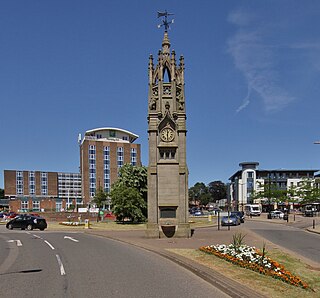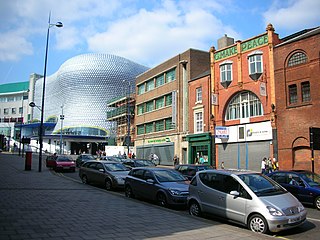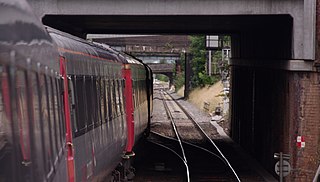
Kenilworth is a market town and civil parish in the Warwick District in Warwickshire, England, 6 miles (10 km) south-west of Coventry, 5 miles (8 km) north of Warwick and 90 miles (140 km) north-west of London. It lies on Finham Brook, a tributary of the River Sowe, which joins the River Avon 2 miles (3 km) north-east of the town. At the 2021 Census, the population was 22,538. The town is home to the ruins of Kenilworth Castle and Kenilworth Abbey.

The Bull Ring is a major shopping area in central Birmingham England, and has been an important feature of Birmingham since the Middle Ages, when its market was first held. Two shopping centres have been built in the area; in the 1960s, and then in 2003; the latter is styled as one word, Bullring. When combined with Grand Central it is the United Kingdom's largest city centre based shopping centre.

Southam is a market town and civil parish in the Stratford-on-Avon district of Warwickshire, England. Southam is situated on the River Stowe, which flows from Napton-on-the-Hill and joins Warwickshire's River Itchen at Stoneythorpe, just outside the town.

Warwick is a market town, civil parish and the county town of Warwickshire in the Warwick District in England, adjacent to the River Avon. It is 9 miles (14 km) south of Coventry, and 19 miles (31 km) south-east of Birmingham. It is adjoined with Leamington Spa and Whitnash.

Ruthin is a market town and community in Denbighshire, Wales, in the south of the Vale of Clwyd. It is Denbighshire's county town. The town, castle and St Peter's Square lie on a hill, skirted by villages such as Pwllglas and Rhewl. The name comes from the Welsh rhudd (red) and din (fort), after the colour of sandstone bedrock, from which the castle was built in 1277–1284. The Old Mill, Ruthin, is nearby. Maen Huail, a registered ancient monument attributed to the brother of Gildas and King Arthur, stands in St Peter's Square.

Sutton Coldfield or the Royal Town of Sutton Coldfield, known locally as Sutton, is a town and civil parish in the City of Birmingham, West Midlands, England. The town lies around 8 miles northeast of Birmingham city centre, 9 miles south of Lichfield, 7 miles southwest of Tamworth and 7 miles east of Walsall.

Warwickshire is a county in the West Midlands region of England. The county town is Warwick, and the largest town is Nuneaton. The county is famous for being the birthplace of William Shakespeare at Stratford-upon-Avon and Victorian novelist George Eliot,, at Nuneaton. Other significant towns include Rugby, Leamington Spa, Bedworth, Kenilworth and Atherstone. The county offers a mix of historic towns and large rural areas. It is a popular destination for international and domestic tourists to explore both medieval and more recent history.

Acocks Green is an area and ward of southeast Birmingham, England. It is named after the Acock family, who built a large house there in 1370. Acocks Green is one of four wards making up Yardley formal district. It is occasionally spelled "Acock's Green". It has frequently been noted on lists of unusual place names.

Digbeth is an area of Central Birmingham, England. Following the destruction of the Inner Ring Road, Digbeth is now considered a district within Birmingham City Centre. As part of the Big City Plan, Digbeth is undergoing a large redevelopment scheme that will regenerate the old industrial buildings into apartments, retail premises, offices and arts facilities. The district is considered to be Birmingham's 'Creative Quarter'.

Birmingham City Council House in Birmingham, England, is the home of Birmingham City Council, and thus the seat of local government for the city. It provides office accommodation for both employed council officers, including the Chief Executive, and elected council members, plus the council chamber, Lord Mayor's Suite, committee rooms and a large and ornate banqueting suite, complete with minstrel's gallery. The first-floor's exterior balcony is used by visiting dignitaries and victorious sports teams, to address crowds assembled below. The Council House, which has its own postcode, B1 1BB, is located in Victoria Square in the city centre and is a Grade II* listed building.

Birmingham Moor Street is one of three main railway stations in the city centre of Birmingham, England, along with Birmingham New Street and Birmingham Snow Hill.

Warwick railway station serves the town of Warwick in Warwickshire, England. The station is served by Chiltern Railways, and also less frequently by West Midlands Trains. It is located around half a mile north of the town centre.
The Birmingham Street Commissioners were a local government body, created in Birmingham, England in 1769, with powers to manage matters such as streets, markets, and policing. Subsequent Improvement Acts of 1773, 1801, and 1812 gave increased powers to the Street Commissioners. They lasted until they were wound up in 1852, and replaced by Birmingham Town Council.
This article is intended to show a timeline of events in the History of Birmingham, England, with a particular focus on the events, people or places that are covered in Wikipedia articles.

The Camp Hill line is a railway line in Birmingham which lies between Kings Norton on the Cross-City Line and Birmingham New Street via Grand Junction on the main lines from Derby and Coventry.

Birmingham City Centre, also known as Central Birmingham and often known locally as town, is the central business district of Birmingham, England. Following the removal of the Inner Ring Road, the city centre is now defined as being the area within the Middle Ring Road. The city centre is undergoing massive redevelopment with the Big City Plan, which means there are now nine emerging districts and the city centre is approximately five times bigger.

Birmingham Curzon Street railway station is the planned northern terminus of Phase 1 of High Speed 2 in the city centre of Birmingham, England. The new railway will connect Birmingham to London Euston via Birmingham Interchange and Old Oak Common. Curzon Street will have seven terminal platforms and is planned to open in 2026.

The following is a timeline of the history of Reading, the county town of Berkshire in England.

William Hollins (1763–1843) was an 18th/19th century English architect and sculptor. His work is largely in the Greek Revival and Gothic styles.

Birmingham Market Hall was a municipal market hall in the Bull Ring area of Birmingham, England, from 1835 to 1940, when the interior and roof were destroyed by enemy bombing; although parts remained in use until final demolition in the 1960s.


















